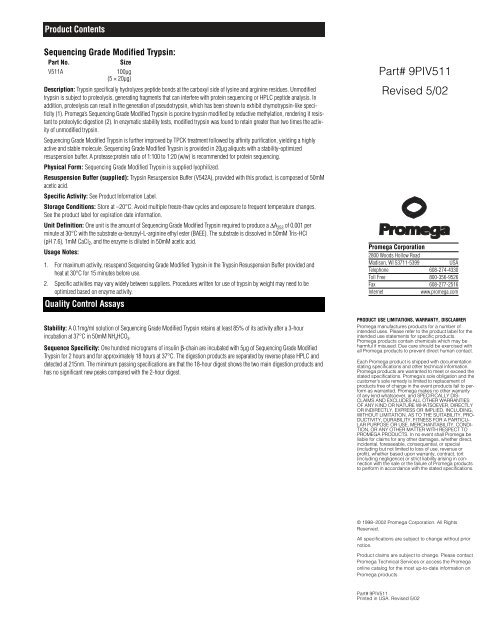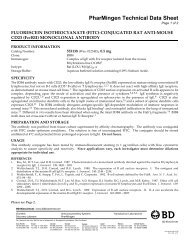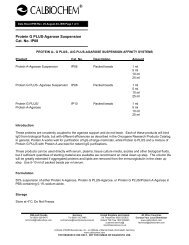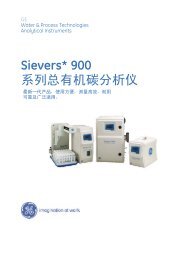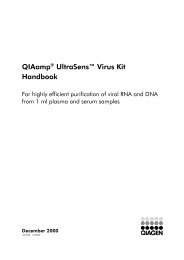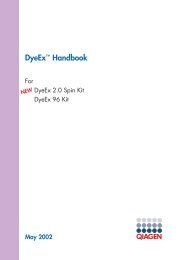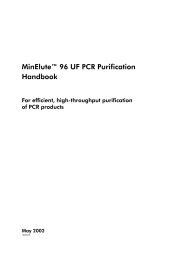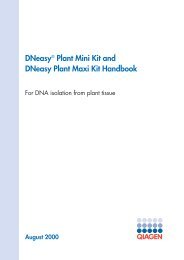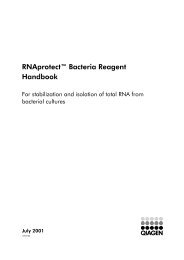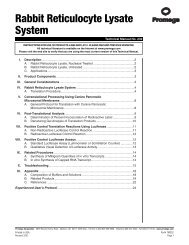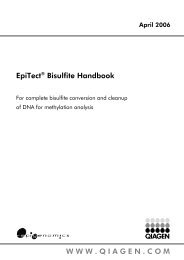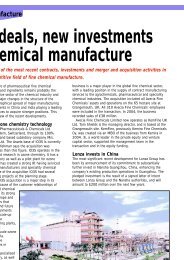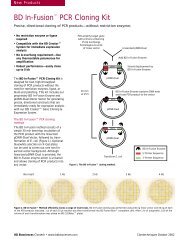Sequencing Grade Modified Trypsin Promega Product Information ...
Sequencing Grade Modified Trypsin Promega Product Information ...
Sequencing Grade Modified Trypsin Promega Product Information ...
You also want an ePaper? Increase the reach of your titles
YUMPU automatically turns print PDFs into web optimized ePapers that Google loves.
<strong>Product</strong> Contents<br />
<strong>Sequencing</strong> <strong>Grade</strong> <strong>Modified</strong> <strong>Trypsin</strong>:<br />
Part No. Size<br />
V511A 100µg<br />
(5 × 20µg)<br />
Description: <strong>Trypsin</strong> specifically hydrolyzes peptide bonds at the carboxyl side of lysine and arginine residues. Unmodified<br />
trypsin is subject to proteolysis, generating fragments that can interfere with protein sequencing or HPLC peptide analysis. In<br />
addition, proteolysis can result in the generation of pseudotrypsin, which has been shown to exhibit chymotrypsin-like specificity<br />
(1). <strong>Promega</strong>’s <strong>Sequencing</strong> <strong>Grade</strong> <strong>Modified</strong> <strong>Trypsin</strong> is porcine trypsin modified by reductive methylation, rendering it resistant<br />
to proteolytic digestion (2). In enzymatic stability tests, modified trypsin was found to retain greater than two times the activity<br />
of unmodified trypsin.<br />
<strong>Sequencing</strong> <strong>Grade</strong> <strong>Modified</strong> <strong>Trypsin</strong> is further improved by TPCK treatment followed by affinity purification, yielding a highly<br />
active and stable molecule. <strong>Sequencing</strong> <strong>Grade</strong> <strong>Modified</strong> <strong>Trypsin</strong> is provided in 20µg aliquots with a stability-optimized<br />
resuspension buffer. A protease:protein ratio of 1:100 to 1:20 (w/w) is recommended for protein sequencing.<br />
Physical Form: <strong>Sequencing</strong> <strong>Grade</strong> <strong>Modified</strong> <strong>Trypsin</strong> is supplied lyophilized.<br />
Resuspension Buffer (supplied): <strong>Trypsin</strong> Resuspension Buffer (V542A), provided with this product, is composed of 50mM<br />
acetic acid.<br />
Specific Activity: See <strong>Product</strong> <strong>Information</strong> Label.<br />
Storage Conditions: Store at –20°C. Avoid multiple freeze-thaw cycles and exposure to frequent temperature changes.<br />
See the product label for expiration date information.<br />
Unit Definition: One unit is the amount of <strong>Sequencing</strong> <strong>Grade</strong> <strong>Modified</strong> <strong>Trypsin</strong> required to produce a ∆A253 of 0.001 per<br />
minute at 30°C with the substrate α-benzoyl-L-arginine ethyl ester (BAEE). The substrate is dissolved in 50mM Tris-HCl<br />
(pH 7.6), 1mM CaCl2, and the enzyme is diluted in 50mM acetic acid.<br />
Usage Notes:<br />
1. For maximum activity, resuspend <strong>Sequencing</strong> <strong>Grade</strong> <strong>Modified</strong> <strong>Trypsin</strong> in the <strong>Trypsin</strong> Resuspension Buffer provided and<br />
heat at 30°C for 15 minutes before use.<br />
2. Specific activities may vary widely between suppliers. Procedures written for use of trypsin by weight may need to be<br />
optimized based on enzyme activity.<br />
Quality Control Assays<br />
Stability: A 0.1mg/ml solution of <strong>Sequencing</strong> <strong>Grade</strong> <strong>Modified</strong> <strong>Trypsin</strong> retains at least 85% of its activity after a 3-hour<br />
incubation at 37°C in 50mM NH4HCO3 .<br />
Sequence Specificity: One hundred micrograms of insulin β-chain are incubated with 5µg of <strong>Sequencing</strong> <strong>Grade</strong> <strong>Modified</strong><br />
<strong>Trypsin</strong> for 2 hours and for approximately 18 hours at 37°C. The digestion products are separated by reverse phase HPLC and<br />
detected at 215nm. The minimum passing specifications are that the 18-hour digest shows the two main digestion products and<br />
has no significant new peaks compared with the 2-hour digest.<br />
Part# 9PIV511<br />
Revised 5/02<br />
<strong>Promega</strong> Corporation<br />
2800 Woods Hollow Road<br />
Madison, WI 53711-5399 USA<br />
Telephone 608-274-4330<br />
Toll Free 800-356-9526<br />
Fax 608-277-2516<br />
Internet www.promega.com<br />
PRODUCT USE LIMITATIONS, WARRANTY, DISCLAIMER<br />
<strong>Promega</strong> manufactures products for a number of<br />
intended uses. Please refer to the product label for the<br />
intended use statements for specific products.<br />
<strong>Promega</strong> products contain chemicals which may be<br />
harmful if misused. Due care should be exercised with<br />
all <strong>Promega</strong> products to prevent direct human contact.<br />
Each <strong>Promega</strong> product is shipped with documentation<br />
stating specifications and other technical information.<br />
<strong>Promega</strong> products are warranted to meet or exceed the<br />
stated specifications. <strong>Promega</strong>'s sole obligation and the<br />
customer's sole remedy is limited to replacement of<br />
products free of charge in the event products fail to perform<br />
as warranted. <strong>Promega</strong> makes no other warranty<br />
of any kind whatsoever, and SPECIFICALLY DIS-<br />
CLAIMS AND EXCLUDES ALL OTHER WARRANTIES<br />
OF ANY KIND OR NATURE WHATSOEVER, DIRECTLY<br />
OR INDIRECTLY, EXPRESS OR IMPLIED, INCLUDING,<br />
WITHOUT LIMITATION, AS TO THE SUITABILITY, PRO-<br />
DUCTIVITY, DURABILITY, FITNESS FOR A PARTICU-<br />
LAR PURPOSE OR USE, MERCHANTABILITY, CONDI-<br />
TION, OR ANY OTHER MATTER WITH RESPECT TO<br />
PROMEGA PRODUCTS. In no event shall <strong>Promega</strong> be<br />
liable for claims for any other damages, whether direct,<br />
incidental, foreseeable, consequential, or special<br />
(including but not limited to loss of use, revenue or<br />
profit), whether based upon warranty, contract, tort<br />
(including negligence) or strict liability arising in connection<br />
with the sale or the failure of <strong>Promega</strong> products<br />
to perform in accordance with the stated specifications.<br />
© 1998–2002 <strong>Promega</strong> Corporation. All Rights<br />
Reserved.<br />
All specifications are subject to change without prior<br />
notice.<br />
<strong>Product</strong> claims are subject to change. Please contact<br />
<strong>Promega</strong> Technical Services or access the <strong>Promega</strong><br />
online catalog for the most up-to-date information on<br />
<strong>Promega</strong> products.<br />
Part# 9PIV511<br />
Printed in USA. Revised 5/02
I. <strong>Product</strong> <strong>Information</strong><br />
A. Specificity<br />
<strong>Trypsin</strong> is a serine protease that specifically cleaves at the carboxylic side of lysine<br />
and arginine. Restrictions to the specificity of trypsin occur when proline is at the<br />
carboxylic side of lysine or arginine; the bond is almost completely resistant to cleavage<br />
by trypsin. Cleavage may also be considerably reduced when acidic residues are<br />
present on either side of a potentially susceptible bond (3).<br />
B. Stability<br />
<strong>Modified</strong> trypsin is maximally active in the pH range of 7–9 and is reversibly<br />
inactivated at pH 4. It is resistant to mild denaturing conditions: 0.1% SDS, 1M urea,<br />
or 10% acetonitrile (4). <strong>Modified</strong> trypsin retains 48% activity in 2M guanidine HCl<br />
(3).<br />
II. Protocol<br />
A. Protein Denaturation<br />
In general, proteins require denaturation and disulfide bond cleavage before<br />
enzymatic digestion can go to completion (3).<br />
Dissolve 1–10mg of the target protein in 6M guanidine HCl (or 6–8M urea), 50mM<br />
Tris-HCl (pH 8), 2–4mM DTT (or β-mercaptoethanol) in a reaction volume of up to<br />
1ml (25µl minimum). Heat at 95°C for 15–20 minutes or at least 60°C for 45–60<br />
minutes. If smaller amounts of protein are to be digested, the recommended conditions<br />
given can be scaled down proportionally. However, under no conditions should<br />
less than 25µl of dissolving agent be used.<br />
After denaturation, allow the reaction to cool and add 50mM NH4HCO3 (pH 7.8) or<br />
50mM Tris-HCl, 1mM CaCl2 (pH 7.6), until the guanidine-HCl or urea concentration<br />
is below 1M.<br />
B. Protease Digestion<br />
Add modified trypsin to a final protease:protein ratio of 1:100 to 1:20 (w/w). Incubate<br />
at 37°C for at least 1 hour. Remove a small aliquot and chill the reaction on ice or<br />
freeze. Add an inhibitor to the aliquot to terminate the protease activity or precipitate<br />
the sample by the addition of TCA to a 10% final concentration. Determine the extent<br />
of digestion by subjecting a portion of the digestion products to reverse phase HPLC<br />
or SDS-PAGE. If further proteolysis is required, return the reaction tube to 37°C and<br />
continue incubating until the desired digestion is obtained (5). The reaction can be<br />
terminated by freezing or by the addition of specific inhibitors. <strong>Trypsin</strong> can also be<br />
inactivated by lowering the pH of the reaction to below 4. <strong>Trypsin</strong> will regain activity<br />
as the pH is raised above 4 (3). Reducing the temperature will decrease the digestion<br />
rate. Longer incubations, up to 24 hours, may be required depending on the nature of<br />
the protein. If using long incubations, be very careful to avoid bacterial contamination.<br />
If a partial digestion of a nondenatured substrate is desired, as would be necessary for<br />
analysis of the domain structure of a protein, incubate the protein with modified<br />
trypsin at a protease:protein ratio of 1:100 to 1:20 in a buffer compatible with the<br />
stability of the target protein.<br />
Usage <strong>Information</strong><br />
III. Related <strong>Product</strong>s<br />
<strong>Product</strong> Size Cat.#<br />
Proteinase K 100mg V3021<br />
For Laboratory Use.<br />
IV. References<br />
1. Keil-Dlouha, V. (1971) Proteolytic activity of pseudotrypsin. FEBS Lett. 16, 291–95.<br />
2. Rice R.H. et al. (1977) Stabilization of bovine trypsin by reductive methylation.<br />
Biochem. Biophys. Acta 492, 316–21.<br />
3. Wilkinson, J.M. (1986) “Fragmentation of Polypeptides by Enzymic Methods”. In:<br />
Practical Protein Chemistry: A Handbook. A. Darbre, ed., John Wiley and Sons, New<br />
York, N.Y.<br />
4. Bond, J.S. (1989) “Commercially Available Proteases”, Appendix II. In: Proteolytic<br />
Enzymes, A Practical Approach. R.J. Beynon and J.S. Bond, eds., IRL Press, Oxford,<br />
U.K. 240.<br />
5. Flannery, A.V., Beynon, R.J. and Bond, J.S. (1989) “Proteolysis of Proteins for<br />
<strong>Sequencing</strong> Analysis and Peptide Mapping”. In: Proteolytic Enzymes: A Practical<br />
Approach. R.J. Beynon and J.S. Bond, eds., IRL Press, Oxford, U.K.<br />
Part# 9PIV511<br />
Printed in USA. Revised 5/02<br />
<strong>Promega</strong> Corporation · 2800 Woods Hollow Road·Madison, WI 53711-5399 U.S.A. · Toll Free in the USA 800-356-9526 · Telephone 608-274-4330 · Internet www.promega.com


